Darwin, the abolitionist – An interview with James Moore
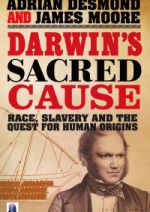 Darwin’s theory of natural selection, first published 150 years ago, has been called a dangerous idea. A new aspect of the theory now joins the Darwinian bibliography: behind it was a “sacred cause”, Darwin’s commitment to the abolition of slavery. The claim is made by Adrian Desmond and James Moore, and unleashed this year in the book Darwin’s Sacred Cause.
Darwin’s theory of natural selection, first published 150 years ago, has been called a dangerous idea. A new aspect of the theory now joins the Darwinian bibliography: behind it was a “sacred cause”, Darwin’s commitment to the abolition of slavery. The claim is made by Adrian Desmond and James Moore, and unleashed this year in the book Darwin’s Sacred Cause.
In a conversation during a visit to São Paulo, Moore told me a bit more about their thesis. Their interpretation, as authors of a hefty biography on the founder of modern evolution-theory, is that an abhorrence of slavery was part of Darwin’s character since childhood. And it pushed him to develop his theory of evolution by common descent.
He also applied his understanding of nature to people to the point of suggesting that men turned the seduction game around relative to other animals – this is the follow up I promised here.
When your Darwin biography was published, it left the impression that we now had the definitive account of Darwin’s life. Did the book open new doors for you, or raised further questions to pursue?
Writing that book nearly killed us. Adrian and I weren’t planning to write anything more together, but then we saw 2009 coming and thought it would be a good time to publish something completely original. I came up with the subject; I had been interested for quite a while on what happened to humans in Darwin’s theorizing, because The Origin of Species supposedly wasn’t about human beings, only The Descent of Man was. So we decided about 10 years ago to work on that difference or discrepancy, and in 2004 we published a Penguin Classics edition of Descent with a long introduction. In that introduction we broached some of the arguments of Darwin’s Sacred Cause, but didn’t offer documentation. We promised in a note to publish more.
Can you in a nutshell explain its thesis?
This is our “Star Wars 2”. “Star Wars 1” was the Darwin biography, “Star Wars 2” is the “prequel”; it asks the question that went unanswered in “Star Wars 1”: “Why did he do it?” The Darwin biography is about an ambitious young man with a terrifying secret, which he keeps quiet for 20 years before being forced to publish. But we never figured out why he tackled evolution in the first place — it was professional suicide. Darwin had everything to lose, even while working in private. Anybody who knows anything about the period knows that going public with evolution for Darwin would have been like Richard Dawkins standing up in Teheran today and declaring that God doesn’t exist! Life for him would suddenly become very difficult. Darwin knew what was at stake, so why did he take the risks? That’s where his moral commitment comes in. In Darwin’s Sacred Cause we trace it in his family background and education, before he ever got to evolution, and then run the story all the way up to The Descent of Man.
So why did he do it? How did his moral views bear on his theorizing?
Darwin is very clear, he is angry. In his private notebooks, he remembers from the Beagle voyage how black people were treated as animals, that slaves were bought and sold and abused like horses or dogs. And for Darwin that was abhorrent because he had been brought up to hate slavery and to believe that black people were of one humanity with himself.
Was it in Brazil that he first saw this?
In the flesh, yes, but at home he’d read about slavery and had been friendly with a black man. At Edinburgh University in his teens he had paid for lessons in bird stuffing from a freed Guyanese black slave named John, and this had reinforced his family’s anti-slavery conviction that black and white people – all the races – had a common humanity. What was theoretical to him until he got to Brazil was the horrors of slavery, which he had only read about. And immediately in Salvador he saw black slaves working along the docks and they seemed to be happy. But when Captain FitzRoy of the Beagle claimed that the slaves of Bahia were happy because he had heard them saying so to one of their masters, Darwin demanded to know what a slave’s word was worth under those circumstances. Obviously slavery was a talking point between them. And then very rapidly Darwin found evidence of the evils he had been taught about since childhood. The realities of slavery were no longer theoretical for him when he had witnessed it among real people in real life. The climax came in 1836 at Itamambuca when he heard the cries, the shrieks of a tortured slave and was powerless to intervene. On that note his voyage ended and the horror of those sounds stayed with him for life.
Does he refer to it in print?
In the revised 1845 edition of his Beagle journal, there’s a blistering attack on slavery — two long paragraphs, more than a page. Here for the first time Darwin opened a window to let the world see what he had witnessed in Brazil. He’d also seen slavery in New Zealand, where people of the same race were made slaves through war and women became sexual slaves. He tells of finding escaped or freed slaves on Mauritius and Saint Helena. Of course all the slaves of England’s Cape colony had been liberated in 1834; Darwin arrived there a year later and hired a Hottentot, or Khoikhoi, groom to be his guide, a diminutive young gentleman whom he found speaking perfect English. In our biography, Darwin’s anti-slavery is a sort of golden thread running through the narrative, which becomes visible from time to time. Weaving all the threads together — what Darwin’s Sacred Cause does — they make a strong rope, strong enough to support a big conclusion. And our big conclusion is that Darwin’s burning hatred of slavery fired his quest not only to show that the races were of one blood, but also to explain how all living things had descended from “one common ancestor” in the family tree of life.
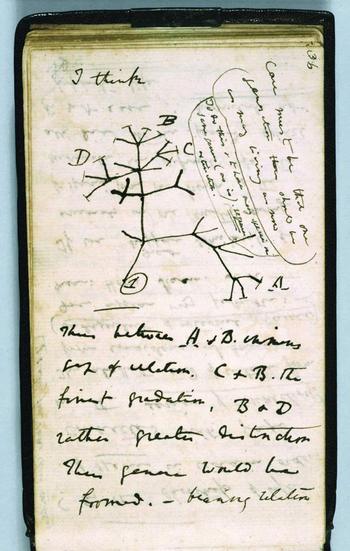
And Darwin’s tree of life is a way to prove that you can’t set races apart and treat them differently.
No, there’s no proof here, the tree is only a starting point. We all grow up taking certain things for granted. Darwin never questioned God’s existence, at least not in print; he never questioned his wife’s love or his family’s love. It was the same with anti-slavery, or anti-cruelty in the broadest sense, a sympathy for living things. Darwin grew up with it. He did go shooting in his teens, and I think some of the birds he massacred weren’t just for food. But by the end of the Beagle voyage he had left off shooting, or he would have his servant do it for scientific purposes. Eventually Darwin gave up the slaughter because he couldn’t stand the suffering it caused. I have heard it argued, rather cynically, that the reason why he talked about slavery the way he did in his private notes and in the Beagle journal is because he imagined that an anti-slavery tone would help sell his theory. “Look, the whole nation has mobilized against slavery. It’s a huge constituency waiting to be recruited for evolution!”
So an anti-slavery moral conscience was widespread in Darwin’s society?
Right. Very few people had a vote in those days, but one way you could register your opinion was by signing a petition to Parliament. These petitions were brought on piles of paper or great long rolls and laid on a table in the House of Commons or the House of Lords in London. Almost all of the petitions were destroyed when the Houses of Parliament burned in October 1834, but a few of them survived with tens of thousands of names. I looked up the parliamentary records and found out where all the petitions came from — such-and-such Baptist chapel, such-and-such anti-slavery association, such-and-such a public meeting. Darwin’s home town of Shrewsbury sent petitions. It was a massive movement, the first protracted experiment in democracy before democracy was extended among the middle classes.
And were there lots of anti-slavery petitions?
Thousands, all very politely worded, begging Parliament to take what measures were necessary to bring about the emancipation of the colonial slaves. I’m sure that we’d find Darwin’s aunts’ and uncles’, his sisters’ and cousins’ signatures in the original petitions if they had survived, but it’s almost enough to know that petitions came from the very villages and towns where the family lived. The anti-slavery movement was the greatest moral movement in British history, at least since the peasant’s rebellion of the 13th century. I’m amazed that historians have taken so long to place Darwin’s life and work in its context.
That was exactly my next question: why hasn’t anyone discussed this?
Because they didn’t ask the right questions. The documents I read in the Wedgwood family papers have been open to historians and biographers for generations. And scholars have gone through the letters, thousands of them, written since the end of the 18th century, looking for evidence of the family’s literary interests, for evidence of early photography, early chemistry, early industrial history. Scholars have toothcombed the documents, but why didn’t they find slavery? They weren’t interested, they were blind to it. And I have to say that digging out the gold was hard work. I spent three weeks in the English Potteries one torrid summer, as hot as it is now in Salvador, perched in a grim university library reading the Wedgwood papers for nine hours a day.
The big work on humans by Darwin is The Descent of Man, but that book is not very much talked about and maybe not much read. Why?
Because it is huge – that’s one reason! Two-third of the text, about 500 pages, is a vast catalogue of evidence for “sexual selection”, ultimately Darwin’s mechanism for explaining the divergence of the human races. Today you have to be interested in the differences between male and female beetles to be gripped by this part of the book. In the 1850s, Darwin was writing a huge work in several volumes to crush the creationist opposition, including followers of the latest theory that made the human races separately created species. He was determined to anticipate every possible objection to his theory of “natural selection” — the title of his big book — and answer them, or at least give evidence for answering them, so that no one would catch him out later. But finally he was forced to publish something quickly, so he cut the big book down, left out the part on sexual selection and the human races, and called the rest On the Origin of Species.
Maybe he also wanted to work more on sexual selection and “man”?
He didn’t want to spoil his case for natural selection and what he had to say about human origins by going forward prematurely. Better to bide his time than come out with something that could be easily refuted. That’s also one of the reasons why Darwin told nobody about the importance of sexual selection, not even his scientific best friend. He hinted at its scope in the Origin of Species, but he hadn’t worked it out far enough to be confident of its power; he didn’t let on until much later that sexual selection was his prize solution to the racial origins problem. Darwin was incapable to do anything by halves. It wasn’t just one barnacle that he had to describe, he had to describe every barnacle species in the world. And not just the living ones, but the extinct ones too! He was obsessive, and in discussing the human races, about which he felt so passionately, he needed even more evidence, if that were possible, to undermine the view that each race had originated as a separate species. The Descent of Man is intimidating because it is so big, but it got that way because sexual selection was so important. Darwin’s catalog of apparently obscure sexual information is his knock-down case for race-making by mate-choosing throughout the animal kingdom.
So he starts with male and female beetles and that’s a step to figuring out how the human races are related?
He had to explain why males and females don’t look alike, not just internally but externally. Why do males tend to be big, violent and armed – I mean “armed” in the sense that they have, say, big biceps or powerful claws for pinching -, as well as gaudy and showy. And why do females tend to be smaller, less aggressive and less showy, not just among birds, which was the crucial case for Darwin, but across the whole animal kingdom, with crustaceans, and spiders, and beetles, and fishes, and birds, and mammals, and primates, the lot (with some exceptions). And humans were no different. Darwin attributed the external differences between the sexes (their “sexual dimorphic characters”) to sexual selection, that is, the competition for mates. It’s there in the bars of São Paulo every weekend: women stand around watching, teasing, coaxing, while the guys beat the hell out of each other as love rivals. Darwin sees this happening in most animals, or at least mammals. As a result of the competition, the bigger, more aggressive males are more successful lovers and pass on their macho characteristics to their sons. The choosier females, who “get lucky” with the best males, also have more offspring, and their daughters inherit the choosiness. Amplify this through the generations and the males pull away from the females, in mind as well as body. Males are both mentally and physically superior to females; males have genius, females normally don’t. Darwin was quite explicit about this. He didn’t think that women should have the vote and he didn’t educate his daughters to university level, because to him biology set limits to female attainment, sexual selection set limits. But sexual selection for Darwin isn’t just about sheer physical and mental power; it’s also about attractiveness — beauty. Unlike the characteristics developed in the prize-fight, those acquired through the sexually selective beauty contest don’t have advantages in the struggle for existence. What beauty marks do is make you sexier, so you’re more successful in leaving copies of yourself: thus male animals got more beautiful or showy than females from their success in enticing them, but in humans — that is, in Darwin’s own culture, which he saw as sovereign — there has been a reversal: males, being more powerful than females, had turned the tables and become the choosers. As a result, women were now more gorgeous than men, displaying characteristics that proved attractive to them. It seemed so obvious to Darwin: why do women adorn themselves with make-up and jewelry? Because they are trying to attract mates, pure and simple. They want to be sexually selected!
And that sets humans apart from the rest?
Males seizing the power of choice through superior strength and wit, yes. Though Darwin knew that females were still drawn to male beauty. He grew a beard in the 1860s, not to attract women of course; but there was a fashion for hairiness as a sign of virility. Victorian gentlemen grew beards like their descendants did in the 1960s. And about the same time women developed a craze for wearing bird feathers on their hats and in their hair, whole stuffed birds even! The world’s avian populations were decimated.
To make hats?
Hats, hairpins, brooches, and other fashion accessories. There is a historical literature about this. A burgeoning female fashion industry is one main reason why the Royal Society for the Protection of Birds was founded. In Britain, young women are still often called birds. You go out at night and try to “pull” a “bird” and “get off’ with”, i.e. mate, with her. It is derogatory to think of women as birds, but Darwin took such behaviour seriously, naturalizing it. He didn’t see sexual selection in humans as a cultural creation, or one among many more or less valid social options; instead he thought that men and woman look and behave as they do because sexual selection made them the way they are. And, ironically, this was the same sexual selection that made whole groups of people look and behave differently, males and females alike, with different physiques and different notions of beauty – the human races. For Darwin, the races had emerged and diverged, body and mind, from a primordial population, with a common ancestry, by the same mating game that made hairy gents and buxom girls in his own day.
So Darwin is still being a naturalist, with his moral views firing his curiosity about nature to understand how humans evolved.
He looked at society and tried to find a natural explanation for it. Darwin was a sociobiologist before there was sociobiology. If the world is governed by natural law, and therefore our evolution is governed by natural law, why shouldn’t everything in society be seen as the product of evolution? Why shouldn’t evolution explain all the ways that men and women live together, not just the shapes of their bodies? Darwin had no problem with that, though most of us today do.
Darwin didn’t make a distinction between a race and a species, he thought each was an artificial construct.
It was a continuum. Species to Darwin were just well defined races. We’re not sexually attracted to other species – normally. Something like this happens if animals are isolated in groups, as on islands: the groups each become modified to subsist on their own patch, they acquire distinguishing “specific” differences, and eventually the groups become sexually repugnant and unavailable to one another.
How does this apply to the discussion today on whether there are human races or not?
Darwin supposed that black people and white people – for his purposes, Africans and Europeans – were on the way to becoming separate species. They weren’t there yet, not by a long shot, but given enough time, and isolation, black and white would diverge permanently. He saw black men tending to have sex with black women, because they find them more attractive; the male sense of black beauty was bred into them as a result of a long history of mating choices. And to Darwin, an English woman was preferentially attractive to him in the same way. That’s the point of repugnance, and Darwin also identified repugnance with body odor. Black people to him smelled different to white. At some point the smell might become so strong and so distasteful, that white and black wouldn’t copulate, and then the races would continue on separate paths to become separate species. So Darwin had no problem with human racial speciation, but he would have added that we can’t begin to conceive of when that might take place. It seemed more likely to him that in coming centuries, long before the races could become separate species, white Europeans would actually have exterminated black Africans.
Why?
Darwin thought that the white Europeans had a superior civilization because they had more superior brains, honed by competition, just as men have better brains than women. What Darwin gives with one hand, he takes away with the other, often. He gives you emancipated slaves, but he doesn’t give you emancipated women; he gives you blacks and whites as equal humans, but he also gives you blacks extinguished by white guns and white diseases and superior white civilization. And Darwin says, in effect, “that’s nature for you”. Progress costs lives. Tragic it might be, but he thinks it’s ultimately for the good.
So even though he hates cruelty and abhors slavery, he still believes that all humans are not equal before nature.
He doesn’t use his moral framework to judge how nature behaves because he holds that this moral framework has been erected by nature – by a beneficent evolution. In the near future, Darwin says in the Descent of Man, humans will have become so improved and so many races will have become extinct — races of people as well as races of primates — that the gap in the ascent of life will not exist as at present between a Hottentot or an aboriginal Australian and a chimpanzee, but between, say, a primate as low as a baboon and some race far higher than contemporary Englishmen. Every species, every race in between, from baboons to Hottentots up to Englishmen will have been extinguished in the progress of life on Earth. We grieve the loss of biodiversity; Darwin seemed to think it was a good thing, even the loss of human racial diversity.
It’s all part of nature.
Yes, but that only makes Darwin a man of his time. Poor old Darwin, he couldn’t see much beyond the nineteenth century, just as we must struggle to see beyond our own.
In 2009, we have heard a lot about Darwin because of the anniversaries, but you’re talking about a different Darwin, aren’t you?
Not entirely. I’m just emphasizing parts of his story that haven’t been told fully or adequately. Adrian and I would have to modify the biography a great deal to work all of it in. At one point in the book we ask whether, far from having everything to lose, there was something important to be gained by theorizing about transmutation. We suggest that Darwin had seen “savages” in the raw in Tierra del Fuego, and there his problem became: how could humans like that and humans like himself — rich, cultured, a Cambridge Master of Arts — come from the hand of the same Creator? Perhaps explaining human diversity was that “something” to be gained, but we didn’t then conceive that Darwin’s experience of slavery in South America might have pointed in the same direction. Now we know: if he cared for one thing more passionately than anything else in life, save his family, it was the emancipation of black slaves. There’s no other candidate for Darwin’s supreme moral concern, his “sacred cause”, which we believe radically shaped his science.
And that’s the new Darwin that you’re showing.
Yes.
This text was originally published by Maria Guimarães in her blog Ciência e ideias/
Hi… come here often?

 The dating game is cruel. It can be poetic like in sea dragons or it can be lethal like in the spider on the left but, in general, it is not easy.
The dating game is cruel. It can be poetic like in sea dragons or it can be lethal like in the spider on the left but, in general, it is not easy.
If the male of the Australian redback spider Latrodectus hasselti doesn’t try hard enough, he is immediately killed by the female he was trying to impress. Jeffrey Stoltz and Maydianne Andrade, from the University of Toronto Scarborough, in Canada, showed that the maiden demands at least 100 minutes of display (I saw the news here). If the suitor fails, the surviving rival wins. And there is more: in the paper they published in October in the Proceedings of the Royal Society B, the researchers also showed that a competent male mesmerizes the female in such a way that it becomes easy for a smart sneaker who didn’t make any effort to mate with her without anyone noticing. Cheateries of the wild world.
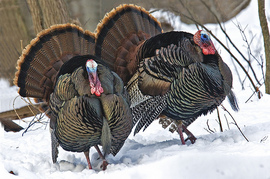 Less akin to Halloween, but not any easier, is the dance of the wild turkeys of the species Meleagris gallopavo, common in the United States.
Less akin to Halloween, but not any easier, is the dance of the wild turkeys of the species Meleagris gallopavo, common in the United States.
In the picture on the right, which I borrowed from flickr (johndykstraphotography, you can see some of the hardship. During the courtship season, the males puff up their feathers, fan out their tails, change their breathing in such a way that their heads become blue, bloodless, and some appendages on the head (the snood, the dewlap and the caruncles) become bright red and engorged with blood. They hold this posture for some time while they take short runs forward and gobble, which can be heard from far away, over the hills. They do this for hours on end, during weeks on end.
During my Ph.D I used to see these animals at Hastings, a research station managed by the Museum of Vertebrate Zoology of the University of California at Berkeley. My labmate Alan Krakauer was studying the turkeys and I had the privilege of helping him out sometimes. But more then helping, I used to get spellbound by the strutting of the turkeys. Unlike the turkey hens, who pecked at the ground looking blasé. I even took loads of pictures, but can’t use one of them here because they’re on slides. Alan was trying to unravel a mistery: all this work to seduce a hen. The males display in pairs like in the picture. Do both win? Do they compete?
After much following the animals, setting huge traps, marking them, watching them and doing genetic analyses, he found that the wild turkeys are a textbook case of cooperative seduction. Only one of the males, always the same, scores. The other one helps with the synchronized dance, but leaves empty-handed. Genetics make up for it, according to Alan: the partners are closely related, so indirectly the secondary male ends up passing his genes forward. That’s kin selection, or Hamilton’s rule (William D. Hamilton mathematically described the theory). The turkey work earned Alan a paper in Nature in 2005.
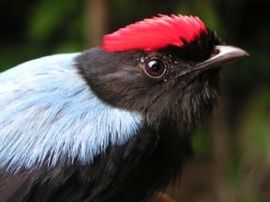 But helping with seduction doesn’t always come from kin solidarity. Another Ph.D labmate, Emily DuVal (now a professor at the Florida State University, the picture is from her lab’s website), studies the charismatic lance-tailed manakin Chiroxiphia lanceolata, in Panama. There, a pair of males sits on a horizontal branch and they fly over each other like a cartwheel. Until the female is convinced. In their case, the dancing partners are not related. What seems to happen is that the subordinate male gains experience while at it, and some day he just might get there.
But helping with seduction doesn’t always come from kin solidarity. Another Ph.D labmate, Emily DuVal (now a professor at the Florida State University, the picture is from her lab’s website), studies the charismatic lance-tailed manakin Chiroxiphia lanceolata, in Panama. There, a pair of males sits on a horizontal branch and they fly over each other like a cartwheel. Until the female is convinced. In their case, the dancing partners are not related. What seems to happen is that the subordinate male gains experience while at it, and some day he just might get there.
Mercival Francisco, from the São Carlos Federal University at Sorocaba, in Brazil, argues that the blue manakin Chiroxiphia caudata, typical of the Brazilian Atlantic Forest, follows another system. In a paper published this year in The Auk, he shows that groups of dancing males (several of them in this species, not just a pair) may or may not be related. As he told me when I wrote a story on his work for Pesquisa magazine, they tend to stay where they were born. By chance, they may end up dancing with kin.
When I told my cousin Laura about the manakins, she expressed regret that the males of these birds are so spruced up but not ours aren´t. “Men have Ferraris,” I joked. A guy was passing by, not in a Ferrari but with a blasting stereo, elbow sticking out of the window and watching out for any women who might be watching. I never saw a woman do this.
 Recently, just as I was getting to São Paulo, traffic stopped as it often does on that point. The Ferrari guy was as stuck as I was, but a lot more upset. I couldn’t help thinking that the males of the rest of the animal world face huge costs to impress the ladies. Ours are not much different. I don’t imagine it is very comfortable, much less economically viable, to own such a car in a city filled with potholes and where you can’t push the gas pedal very far down.
Recently, just as I was getting to São Paulo, traffic stopped as it often does on that point. The Ferrari guy was as stuck as I was, but a lot more upset. I couldn’t help thinking that the males of the rest of the animal world face huge costs to impress the ladies. Ours are not much different. I don’t imagine it is very comfortable, much less economically viable, to own such a car in a city filled with potholes and where you can’t push the gas pedal very far down.
Darwin reserved a special room for sexual selection in his theories, it was one of the major disagreements he had with Alfred Russel Wallace, codiscoverer of natural selection. I’ll come back to this soon.
======================================
Written by Maria Guimaraes, originally published at her blog Ciencias e Ideias
Stoltz JA, & Andrade MC (2009). Female’s courtship threshold allows intruding males to mate with reduced effort. Proceedings. Biological sciences / The Royal Society PMID: 19864292
Krakauer, A. (2005). Kin selection and cooperative courtship in wild turkeys Nature, 434 (7029), 69-72 DOI: 10.1038/nature03325
DuVal EH (2007). Adaptive advantages of cooperative courtship for subordinate male lance-tailed manakins. The American naturalist, 169 (4), 423-32 PMID: 17427119
Francisco, M., Gibbs, H., & Galetti, P. (2009). Patterns of Individual Relatedness at Blue Manakin ( ) Leks
The Auk, 126 (1), 47-53 DOI: 10.1525/auk.2009.08030
Whatever she wants – sexual selection
This post was translated by Igor Santos from the original published by Atila at the Brazilian blog Rainha Vermelha.
==================================================================
Sexual selection is not the freshest of news. Darwin’s grandfather Erasmus had already commented on it. [1]
But a very pertinent question is why it occurs, or at least, what is selected. After all, why does a female finds a male sexy?
Two hypotheses could explain that. Fisher proposed the sexy gene hypothesis. He argues that, whatever the characteristic chosen by females, if it comes from a gene, that gene must become common within a population just because it has been picked up. A female that chooses a male with the sexy gene will have offsprings with that very gene, which in turn will be chosen by other females, spreading it.
The other hypothesis is the good genes one. According to it, when females prefer a certain trace, they are actually opting for a male’s good health, reflected on that given trace. For instance, a male with bright red feathers that uses carotene to increase the redness. Only a very healthy male has enough carotene to “waste” on plumage, so whoever gets the redder male will have healthier offspring and will have been favored by sexual selection.
Both hypotheses seem to be correct. It all depends on the cost involved in the choice. When its not too cost-intensive for the females to choose (e.g. birds that gather for “exhibition parades” with heaps of males, sexy gene might prevail, like in peacock’s tails). In other scenarios, where choice uses resoures, be it looking around for males or exposing their presence to predators for the exhibition, the selected characteristic must have added value, a good gene.
But neither hypothesis explain how a characteristic begins to be selected. Why do females prefer a certain color, a song or any other thing? Where does the preference come from?
Like with most frogs, the song is used to attract partners. But in closer-related species, males don’t do the second part, they only chant the “win” bit. Now a bizarre fact.
When the P. pustulosus melody was played through loudspeakers to females of other close-related species, they like it better than their own species’ call! They prefered the screeching end, albeit they had never heard it before, since their own kind does not do it. Therefore, they already have the nervous circuit that make them like that kind of song better, but only the P. pustulosus males use them.
There is a bias preference amongst the females, who hear and prefer that frequency, but males of the other more than 40 species of the same genus can’t use it. [2]

Platy (left) and Green Swordtail (right). Same genus, but only one has a sword-shaped tail.
Other species follow the same path. In Xiphophorus fish, only the swordfish has its anal fin elongated. The longer the tail, more successful the owner. In close-related species, like platy, on which that long fin inexists, the same bias repeats itself. If artificial tails are attached to the males, thay become more popular. Again, females still prefer something they have never seen before. Probably because they prefer bigger males.
In more and more species, from birds with more intricate melodies to mite with specialized appendages on their pedipalps, we find characteristics in one species that are not present in others of the same genus, but are quite successful among them. It is about those who manage to explore a tendency already present.
The implication is that preference for a trait is inherent to females according to the more utilized senses. It could be the “eyes” on the pattern of a peacock’s tail, since they are vision-oriented birds and need to be in constant lookout for predators. And that crest is sure to attract attention. Senses and nervous circuits that are already in constant use for, say, searching food – like a spider’s sense of touch – are co-utilized or re-routed for sexual function. Which is expected, for our senses resources are limited. [3]
Nothing more fitting for evolution. Females preference is already there and males born with tiny variations. The one with a novelty-colored fin or a more refined song will be chosen and have more descendents rather than their rivals without those characteristics. With time, that gene becomes so ordinary as to level the success rate of all males, until one displays another interesting change, and the cycle starts over.
After all, the ladies like surprises.
Sources:
[1] Smith, C. U. M. “Erasmus Darwin saw sexual selection before his grandson.” Nature 459, no. 7245 (Maio 21, 2009): 321. DOI:10.1038/459321d.
[2] Ryan, M., Fox, J., Wilczynski, W., & Rand, A. (1990). Sexual selection for sensory exploitation in the frog Physalaemus
pustulosus Nature, 343 (6253), 66-67 DOI: 10.1038/343066a0
[3] Ryan, M. (1998). Sexual Selection, Receiver Biases, and the Evolution of Sex Differences Science, 281 (5385), 1999-2003 DOI: 10.1126/science.281.5385.1999
The miracle of the falling cat
A cat fell from the 26th floor in New York. What happened to the kitten? Nothing.

The name of the cat is Lucky. Of course, with a name like that, it was no surprise that a miracle saved him. According to the owner:
“That’s the thing about Lucky Miraculous,” HOSTETLER told “GMA.” “He has been [lucky] since we got him.” Source
NOT!
If the cat was really lucky, would it fall from the window? Does every miracle requires something bad happening before?
Actually, the cat would be more lucky if he had dropped the 7th floor and survived. Why?
 Based on the records of cat falls, the rule “the higher, the worse” is not true. Moreover, a cat survived a 32 floors fall in the concrete, something like 450 feet, and only spent two days of observation and got a chipped tooth. Here is the figure everyone wants to see:
Based on the records of cat falls, the rule “the higher, the worse” is not true. Moreover, a cat survived a 32 floors fall in the concrete, something like 450 feet, and only spent two days of observation and got a chipped tooth. Here is the figure everyone wants to see:
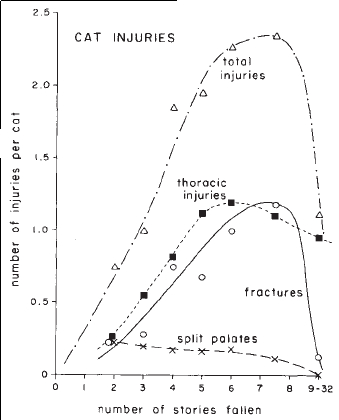
Source: Nature.
DISCLAIMER, nobody was throwing kittens out the window to calculate
the damage, these number are simply records of veterinary care
emergencies.
The majority of cats (90%) in this study survived (omitting the ones euthanatized by owners unable to afford treatment). The most common traumas of those who died were shock and thoracic injuries. The figure above shows that the frequency of injuries increase with the height but, instead of continuing and stabilizing at 100%, as would have happened if we were talking about people, it starts to fall! Cats suffer worst fates when they fall between the sixth and eighth floor.
Not all animals need to be afraid of gravity! Indeed, the vast majority of them, in number and diversity, do not. The damage suffered by cats that fall from different heights depends on two factors: the force that results from the animal’s mass and acceleration (gravity) F = Mxa and the area where the force is distributed F/A. Here lies the difference.
The larger the animal, the heavier it is, but the area it occupies does not increase proportionately. The size determines the weight of the animal, so the force it exerts when it falls increases in three dimensions, cubic. But the surface of the animal increases in two dimensions, a square relation. The greater the surface/volume ratio, the more air resistance the animal does and smaller is the final speed during his fall. Just think of a aluminum sheet dropping open or mashed.This means that ants, beetles, spiders and mice also do not need to worry about the height they fall. A fall of 1 foot or 20 thousand feet does not matter for them, since the final speed in fall is low and they distribute the impact in a relatively larger area. Meanwhile, any little fall for an elephant is dangerous.
When a cat falls, its terminal velocity (maximum speed in the fall) is about 60 mph, and the impact is distributed among the 4 limbs because the effective gyroscope that allows cats to turn during the fall and land almost always on feet, the vestibular system – hence the difference between a cat and a dog falling. Humans reach a terminal velocity of 120 mph and usually land on their head or legs, which means a more lethal fall, with more internal bleeding and head injuries.
When cats begin to fall, they stretch the limbs and increase their tension. When the height is greater, as in the case of higher floors, the cat has enough time to relax and let their limbs stay horizontally, increasing its surface, reducing the terminal velocity and distributing better the impact. By flexing the legs, they absorb the impact, as a spring. One of the most common injuries in cat drops is broken jaw, because the body relax as a whole and lets the jaw hit the floor.
Through their climbers history, the evolution of cats explains their nine lives. They need no miracle for that.
Diamond, J. (1988). Why cats have nine lives Nature, 332 (6165), 586-587 DOI: 10.1038/332586a0
========================
This post was translated by Atila from the original published at the Brazilian blog Rainha Vermelha.
About horned beetles
This is a translated version of this post, written originally in Portuguese by Atila Iamarino at Rainha Vermelha and translated by Igor Santos.
—————————————————————
Or “What don’t we do for women”..
Hard battle

Horns in beetles are a special feature. Not satisfied being male-only they are also unique among the insect species. And they are not made of mouth parts, nor antennae or even modified legs. They are horns. Horns that came to the attention of this Charles Darwin guy, who had a love affair with insects since his childhood and used the horned ones to explain sexual selection.
[Translator’s note: the terms “love affair with insects” and “sexual” were not meant to be related in that way].
Male beetles use those horns to battle for the females. They joust in restrictive environments, like tunnels dug by them for the egg-laying business of their lady counterparts. And, pretty much always, the longer the horn, the greater the number of victories, which translate into more fertilized females and more descendants
Like any structure subject to sexual selection (even though the choice is not up to the female, winning battles ensure reproduction), they are an impressive diversifying force. Horned beetles are extremely numerous and varied. Responsible for one of the greatest events in speciation, the diversity in shapes of horns are an example of the power of an evolutionary dispute.
Did anyone mention Red Queen?








